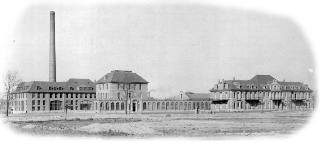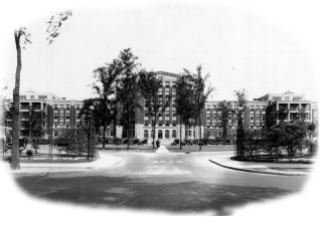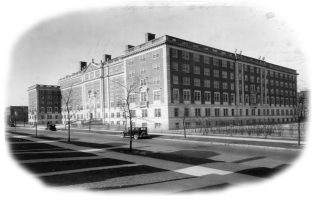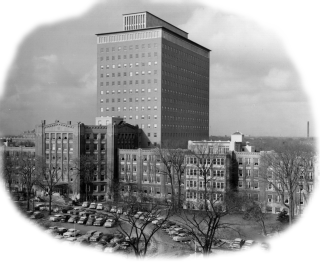Henry Ford Hospital History

Henry Ford Hospital, located at what was then the edge of the city of Detroit at Hamilton and West Grand Boulevard, opened its doors to patients in October 1915. A Private Patient Building accommodated 48 patients, and several other small buildings housed the surgical pavilion, research quarters, kitchens and laundry facilities, the power plant, and garage. The Hospital was financed and built by Henry Ford, who organized a closed staff of physicians and surgeons, many of whom came from Johns Hopkins.

Within two years, construction of a larger building began on the same 20 acre site. The shell of this incomplete building was turned over to the federal government in 1918 for use as U.S. Army General Hospital No. 36, which provided care for returning veterans of World War I while the Henry Ford Hospital staff were away in military service. After the war the 50,000 square foot building was completed, opening in 1921 and providing 500 new beds for the growing Detroit community. The staff grew over the years, and its threefold commitment to patient care, research, and medical education built on traditions that came with the original staff from Johns Hopkins.

In 1925, a 300 room Nurses Home named for Clara Ford was opened to house students of the newly formed Henry Ford Hospital School of Nursing. The diploma school offered training in basic sciences and nursing practice, graduating more than 5000 students in the ensuing 71 years of its operation. The School was known for its high standards and excellence in education and practice, and "Ford grads" were easily recognized by their unique caps as well as for their skillful care of patients.
The Edsel B. Ford Institute for Medical Research was established at Henry Ford Hospital in 1947 as the Hospital's formal division of scientific research. The Institute developed over the years and later became a Research Department with activities involving millions of dollar in research grants annually and projects in many areas of medical and surgical specialization.

By the 1950s, the Hospital's operations and practice had grown so that expansion was necessary. In early 1955, the Hospital celebrated the opening of a 17-story Clinic Building which housed fourteen specialty outpatient clinics, a 35,000 volume medical library and twenty new operating rooms. The new facility relieved crowding in the main hospital and space was reopened there for inpatient care.
In the 1970s, the Hospital's leadership recognized changes in the demographics of the city and its patient base. Serious changes in the structure of the Hospital were needed in order to meet the needs of those patients who had moved out into the suburbs. Two large outpatient medical centers were opened in 1975, one in Dearborn and one in West Bloomfield. Within a short time, many former Henry Ford Hospital patients returned as they found the care they required available closer to their homes. The new medical centers featured family and pediatric care, dentistry, behavioral services, radiology, and pharmacy services. Thus began the expansion of Henry Ford Hospital services into the Detroit metropolitan area.
Within ten years, five other suburban centers opened, including a specialty center for the treatment of chemical and alcohol dependency called Maplegrove. Improvements and additions at the Detroit campus continued throughout this period, and included the construction of the Benson Ford Education and Research Building opened in 1977 and a 190-unit apartment building for house officers and their families. A 210,000 square foot addition called Eleanor Clay Ford Pavilion opened in 1982 housing new operating rooms, modern emergency room facilities, intensive care units, and radiology facilities. New equipment and technologies kept the Hospital at the forefront of medical capability.
The Hospital's Board of Trustees reorganized its corporate structure in 1983, incorporating a parent organization called the Henry Ford Health Care Corporation to oversee the operations of the Hospital and two subsidiaries. During the late 1980s, the Hospital affiliated with Cottage, Wyandotte and Kingswood Hospitals, and added an HMO called Health Alliance Plan. By 1990, with these additions and 25 suburban centers, another corporate reorganization established the Henry Ford Health.
Moving into the 2000s, Henry Ford Health continued to grow. Having first affiliated with St. Joseph's Mercy of Macomb Hospitals in the 1980s, the system fully acquired those hospitals in 2007 creating the Henry Ford Macomb Hospitals in Clinton Township and Mt. Clemens. In March of 2009, Henry Ford Health opened the state-of-the-art, 730,000 square foot Henry Ford West Bloomfield Hospital adjacent to the existing medical center. The West Bloomfield hospital became the second hospital built by Henry Ford from the ground up.
Presently, Henry Ford Health handles approximately 3.2 million patient visits annually. With more than 23,000 employees, Henry Ford Health is the 5th largest employer in metro Detroit. The employees and physicians take Henry Ford Health's mission seriously to provide exceptional, cost effective, quality care strengthened by education and research - carrying on the traditions of the founder and the original staff of the Henry Ford Hospital.
For additional information, please see the Historical Highlights Guide.
Photos Courtesy of the Conrad R. Lam Archives, Henry Ford Health, Detroit, Michigan
Conrad R. Lam ArchivesA Division of the Sladen Libraries of Henry Ford Health
One Ford Place, 5H
Detroit, Michigan 48202
(313) 916-2550 Phone
(313) 874-4730 Fax
.svg?iar=0&hash=F6049510E33E4E6D8196C26CCC0A64A4)

/hfh-logo-main--white.svg?iar=0&hash=ED491CBFADFB7670FAE94559C98D7798)